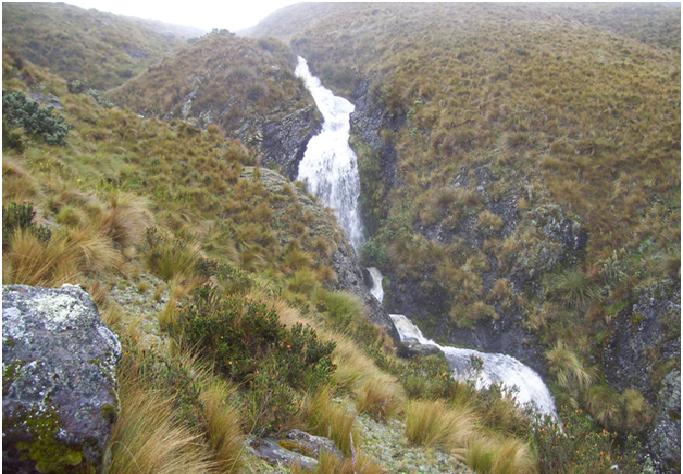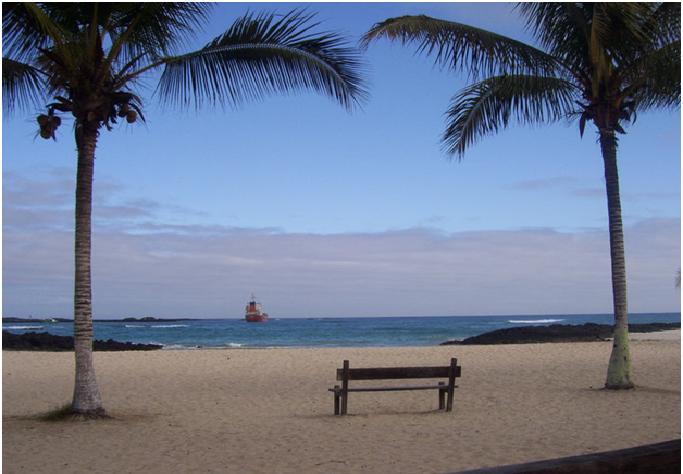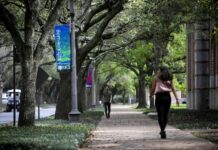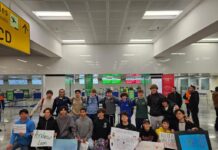
Fifty meters above the Mindo Cloud forest, I fly through the air at 35 miles per hour, supported only by a harness and a carabineer. The metal cable screaming due to speed and friction, I soar over the foliage, never taking my eyes off the tangled branches that make up the rainforest canopy. After arriving safely at the next platform, I unhook myself from the line and journey up the side of a mountain to another platform, a deck overlooking the entire valley, in order to continue my 3,500 meter journey over the Mindo landscape.
This past April, I was lucky enough to be chosen to accompany Jesuit science teacher Ms. Clayton and a group from Pennsylvania to Ecuador and the Galapagos Islands after she received a scholarship for herself and one student. From July 10th to July 23rd, we accompanied the student travel branch of the Discovery Channel, Discovery Student Adventures. For 13 days, we toured Colonial Quito, mountain biked around the tallest volcano in Ecuador, zip-lined through the rainforest, camped next to Incan ruins, fished for crabs in 3 foot deep mud, snorkeled with sea lions, and learned about the importance of the Galapagos Islands to Science.
I experienced a new culture, a new way of life, as our group moved through the highlands and lowlands of Ecuador, touring the cities of Quito, Riobamba, and Cuenca. The evidence of Jesuit influence in Ecuador was awe-inspiring. Despite being immersed in a different culture, I still felt at home while touring La Compañía de Jesus, a Jesuit Church in Quito. Ornate, brilliant, and decorated in gold, La Compañía took the Jesuits 160 years to build. As we walked through the church, I immediately noticed the “IHS” emblem identical to the one inside our Hall of Honors. After also seeing “A.M.D.G.” written on the bells, the walls, and the floor of the church, Ms. Clayton and I proudly told the group what it stood for and how significant the motto was to the Jesuit education I am receiving.
Not only did we tour Quito, but also we visited the historic city of Cuenca, the home of the famous Panama hat factory. Rich in culture and historical significance, Cuenca is the epitome of celebration and festivities. The stress placed on religion became immediately evident when we stumbled upon a parade honoring the Virgin Mary. The whole community, ranging from the Ecuadorian army to 6-month old children participated in the parade, singing songs of adoration, throwing flowers, and even setting off firecrackers. Celebrations full of music, dancing, and fireworks continuously bring the Cuenca community together.
The sense of communal harmony throughout Ecuador, present in the citizens’ worshipping, working, and celebrating, was an eye-opening experience. While driving through the countryside, we observed “minga,” the process of community members gathering to complete a task that benefits the area as a whole. After our guide explained that not monetary retribution, but rather the reward of being part of the community motivated people to help each other, I remembered the profile of a Jesuit Graduate. The type of service these people were performing is exactly what my Jesuit education calls me to do: help others not for the benefit of reciprocation, but for the benefit of the community.
At Las Mariposas de Mindo, a butterfly breeding farm, our group learned about the 25 different species of butterflies and how important they were to the environment. As thousands of butterflies flew around us, some of which were larger than my hand, I could not help but remember the Freshman Insect Project.
One of the most memorable experiences of my trip was hiking up a waterfall in the Andes Mountains. After reaching what seemed to be the top of the falls at a summit of 12,700 feet, I decided to head to a peak in the distance with a couple of others from the group. With no marked trail, we made our way up the 45-degree incline and continued on, inspired by our guide’s “cumbre o muerte” (“summit or die”) speech. Short of breath, we realized how scarce the air was and literally breathed the mist from the clouds rolling across the mountain range. By about 5:45 in the afternoon, we reached a summit of 13,400 feet, a light fog and rocks completely surrounding us. It was a race against time as we made our way down the mountain side, blazing our own trail as the sun started setting. 6:30 P.M. Complete darkness. With more than half the descent to go, we groped our way through the brush, half sliding and half climbing down the mountain, focusing on the feet of the person in front of us and the faint glimmer of our camp lights in the distance. Luckily, we reached the bottom at about 7:30. Only then did we realize just how steep our descent actually was, and how lucky we were to have made it even after the sun had set.
Camping in the Andes next to Incan ruins entailed trekking 8 miles on the Incan trail through mud, sinkholes, and rivers. Completely covered in what I hoped was mud, I was overjoyed when we reached the trail’s end. Walking on a trail that the Incas used hundreds of years ago amazed me, a feeling that only grew once we reached Ingapirca, the largest ruins site in Ecuador. The Cañaris and the Incas shared Ingapirca, a sacred site housing the military and the sun temple.
On one of our last days in Ecuador, we went to the Manglares Churute Ecological Reserve in Guayaquil. Once there, we put on “crabbing” clothes and took a bird-watching tour by boat, cruising through the mangrove trees and watching flocks of herons search for fish. As the mountain water flows down from the Ecuadorean highlands, it passes through the Ecological Reserve, the mangrove trees purifying the precious resource before it flows into the Pacific Ocean. When I was told that I would be working with crab fishermen, I had no idea what it entailed. Trudging through mud up to my waist in some places, I followed the workers through countless mangrove branches in search for these crabs. The biggest surprise of the day was learning how we were to catch these crabs. Practiced experts, these workers quickly located small holes in the mud and told us to reach down them, blindly feeling around for red crabs. After 5 minutes of digging and numerous face-plants into the mud, I finally found the crab I was after and excitedly pulled it out to show the workers. The reward for our “crabbing” efforts was receiving a dinner made of the crabs we had caught and enjoying the amazing ceviche that a family on the Reserve cooked.
Our destination for the remainder of the trip was the Galapagos Islands. The first day we arrived on San Cristobal Island, we went out to lunch to try the local cuisine and discovered Wahoo, an excellent tasting fish. I also learned about the fragility of the Galapagos ecosystem and saw the measures being taken to preserve the Galapagos Giant Tortoise Species at the three different tortoise breeding centers that we visited. Lonesome George, the last Galapagos Tortoise of his species, serves as a reminder of how important it is to preserve the environment and the ramifications sure to ensue if we lose sight of the knowledge we can gain from nature. I toured the Charles Darwin Station and learned about evolution and natural selection, observing the differences among various species first-hand.
My favorite activity in the Galapagos Islands was snorkeling with sea lions and sea turtles at La Loberia, Concha de Perla, and the Galapagos beach we camped on. The sea lions, playful and curious, swam with us as we observed sting rays, turtles, and all types of fish in their natural habitats. We even got to play a game of fetch with a sea lion pup that brought us the mangrove seed it was chewing on. Snorkeling in the Galapagos Islands was like swimming in a gigantic aquarium. Even though the water was freezing cold, it was teeming with marine life oblivious to our presence, providing us with an opportunity to observe creatures we had never seen in real life before.
Ecuador and the Galapagos Islands are not only unique places to learn about the environment through hands-on activities and first-hand observation, but also are sources for growth and understanding.

After coming home from this experience, I consider myself to be more cultured and above all, appreciative of the opportunity I was given to learn about the history, ecology, and culture of a foreign country. I will never forget this once in a lifetime experience and cannot wait to use the knowledge I gained while studying Biology in college.





